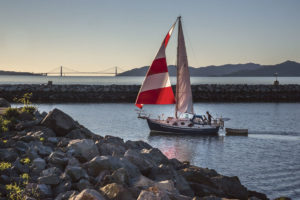Martin Luther King Jr. Regional Shoreline is a sliver of green fringing San Leandro Bay. Cheek by jowl with Interstate 880, the Oakland airport, the Coliseum, and Alameda, it’s about as urban a setting as you can find. Yet the marsh here supports some of the highest densities of endangered California clapper rails in the entire San Francisco estuary.
This park is home to Damon Slough, site of the first restoration project undertaken by the nonprofit Save the Bay. Tucked nearby is one of the group’s two native plant nurseries, created to supply seedlings for the group’s five restoration projects around the Bay.
On a blustery day in April, a dozen volunteers stand in the garden’s shade house bundled up in sweatshirts listening to Dylan Chapple, Save the Bay’s restoration specialist. “This year Save the Bay turns 50,” he begins. “If we had tried standing next to San Leandro Bay 50 years ago, it would be a little stinky–sewage flowed directly into the Bay.”
Both the Bay and the organization have come a long way since then. Today, several flats of sticky monkeyflower seedlings wait on the nursery’s benches. Volunteers will separate the fingernail-size plants and transplant each one to a long yellow tube called a stub. Next winter the plants will go into the ground.
Save the Bay’s restoration sites mostly target the transition zone just uphill of tidal marshes. These narrow regions support a variety of species and shelter creatures seeking refuge during high tides.
Since 1850, 90 percent of Bay tidal marshes have been lost, but development destroyed even more of the transition zone. And unlike tidal marsh, which can recover with little more than a breached levee, a degraded transition zone will remain so without intervention.
“The stuff around the edges needs our help,” Chapple explains. “Our first goal is to get the soil back in shape to support natives.”
Between its Oakland nursery, established in 2002, and another at Palo Alto Baylands, established in 2004, Save the Bay grows 33 different species of native plants, most from seed hand-collected in the watershed associated with each project. Last year staff and volunteers transplanted 25,000 seedlings to the field.
The program’s reliance on volunteers can’t be overstated. This year, over 5,000 individuals will donate 20,000 hours, the equivalent of 10 full-time employees.
The volunteers at the Oakland nursery are a mix of veterans and newcomers, hailing from Oakland, Berkeley, Moraga, and Alameda. Mary Beth Tanner and her son Ben are here for the first time. Ben, who is volunteering as part of a student service project at Campolindo High School, says the public TV documentary Saving the Bay inspired him to choose a project focusing on environmental restoration. “You can’t have good economics without a good environment,” he says.
Alan Tong started coming to the Oakland nursery five years ago. “I realized I wasn’t getting out much, so I decided to combine trips with doing positive work.”
The following Wednesday, a different group of volunteers at Palo Alto Baylands gets to test-run the newly constructed greenhouse, which should ensure better seedling survival rates.
Volunteers here are also transplanting sticky monkeyflower. High school junior Maroun Abiramia teases out a tiny seedling with impressive roots. “You have to be gentle with them,” he says, holding it up for his friends to admire. He and his classmates from Hillsdale High School are happy with the hands-on work. “We should be doing things other than just absorbing information.”
Dorothy Bair agrees. She and a colleague are repeat volunteers from Arden Realty, which grants paid time off for community service. “The fact that we get outside is wonderful,” says Bair.
At the end of the day, Chapple thanks the volunteers, invites them back, and urges them to share what they’ve learned. “That’s really the most important thing you can do,” he says. “If people don’t know about something, how can they care about it?”
Learn more at savesfbay.org/volunteer and savesfbay.org/50years.

.jpg)



